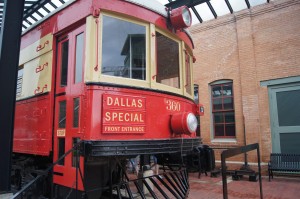People know Plano Texas as the headquarters for companies like Dell Services, Cinemark, J.C. Penney, and many more. Prior to the big corporations, Plano, like many other Texas towns, depended upon the railroads and railways.
The Interurban Railway Museum located on the edge of the old Plano downtown, tells the story of Dallas’ early mass transit system. Over 100 years ago, an electric railway linked towns from Denison in the north to Waco in the south.
Electric Trains. The Interurban Railway Museum is housed in the Plano depot for the Texas Electric Railway. Not only did passengers and mail pass through the depot, it also  served as a transformer station, stepping down electric voltage so that it could be used by the railway. Hands-on exhibits in the museum give visitors, young and old, a chance to learn about the mechanics behind powering an electric train. Who knew physics could be so much fun!
served as a transformer station, stepping down electric voltage so that it could be used by the railway. Hands-on exhibits in the museum give visitors, young and old, a chance to learn about the mechanics behind powering an electric train. Who knew physics could be so much fun!
Post Office on Wheels. Located outside the museum, you’ll find a fully restored rail car. Many interurban railways served as rolling post offices. Look at letters before 1948, and you may find the RPO cancellation stamp. That indicates the letter was sorted and processed in a railway post office. While not unique, the Texas Electric Railway did more than just sort mail. Its cars served as fully functioning post offices. You can explore the postal section at the rear of the rail car. Forward from the mail room, you’ll find the passenger section. The railway was a product of its time with segregated seating. The white section of the car was the smoking section, and the colored section was designated non-smoking. Ironic.
Sample Plano History. The Interurban Railway Museum also tells the story of early Plano. First settled in the 1840s, the city fathers named the town, using what they thought was the Spanish word for plains. As it turns out, the city founders needed a language refresher course as Plano, in Spanish, translates to flat. Corn was the region’s primary crop until the Houston and Texas Central Railroad came to town in the 1870s. Cotton became king with the railroad providing the means to transport the crop. By the 1930s, share croppers, growing mostly cotton, operated over 70 percent of the area farmland.
End of an Era. The share croppers and the Texas Electric Railway both struggled during the Great Depression. In fact, the company went through bankruptcy and reorganization in 1935 World War II saw a resurgence in the railway, but the end of the war also heralded the end of the railway. With steel and rubber no longer needed for wartime products, people could afford to buy automobiles. The railway, offering its mass-transit product, couldn’t compete with the auto. The last run of the Texas Electric Railway was in 1948.
When You Visit. The Interurban Railway Museum (901 E. 15th Street, Plano) is open Monday through Friday from 10 a.m. to 2 p.m., and from 1 – 5 p.m. on Saturday. Admission is free (donations are appreciated). If you visit on the weekdays, the museum docent will likely be a member of the Plano Conservancy for Historic Preservation. Conservancy volunteers are a wealth of information not only on the Texas Electric Railway, but also the history of this corner of Texas.

